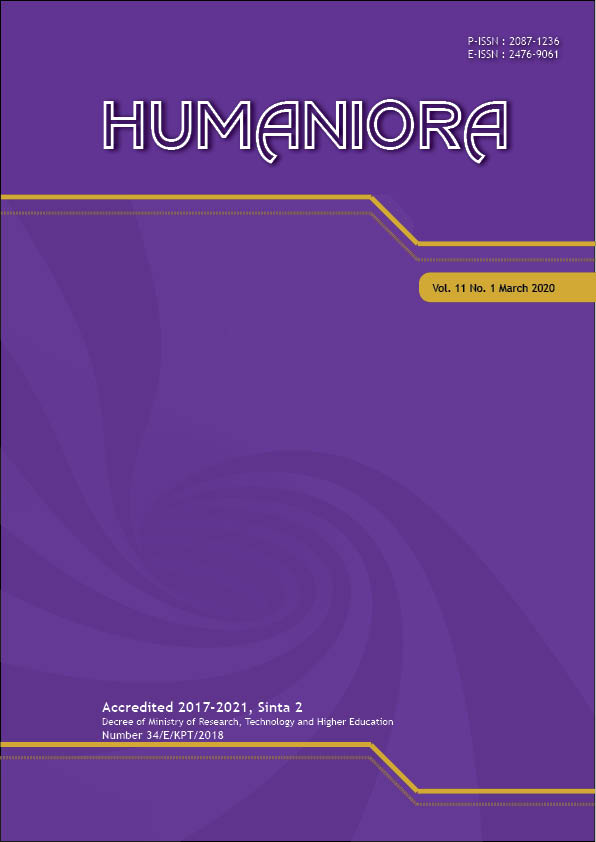Disruptive Innovation: A Case of Solving Hoax Information in Indonesia
DOI:
https://doi.org/10.21512/humaniora.v11i1.6088Keywords:
disruptive innovation, Information Communication of Technology (ICT), millennial era, hoax informationAbstract
The research discussed hoax information as an effect of disruptive innovation and how to solve it in society. It applied a qualitative descriptive method with a case study focusing on hoax information of 10 million Chinese workers who came to Indonesia. The research was a library research conducted through various sources of literature and journals. Data analysis was carried out by answering the points that were analyzed and cross-checked to other data sources in order to answer the research questions. It is found that living in the millennial changes rapidly; various forms of innovation are born and developed very quickly, and so do the problems and challenges. To prevent the spread of hoax information, some efforts need to be done to understand the process, ethics implementation, law enforcement, and accountability of information.
References
Alpi, K. M., & Evans, J. J. (2019). Distinguishing case study as a research method from case reports as a publication type. Journal of Medical Library Assosiation, 107(1), 1-5. https://doi.org/10.5195/jmla.2019.615.
Anggarini, V. (February 14th, 2018). Awas, informasi hoax soal tenaga kerja China di Indonesia. Retrieved from https://kumparan.com/vidya-anggraini/awas-informasi-hoax-soal-tenaga-kerja-china-di-indonesia.
Baldacchino (2008). Entrepreneurial creativity and innovation. The First International Conference on Strategic Innovation and Future Creativity. Malta, University Malta.
Christensen, C. M. (1997). The innovator’s dilemma: When new technologies cause great firms to fail. Boston, Massachusetts: Harvard Business School Press.
Christensen, C. M., McDonald, R., Altman, E. J., & Palmer, J. E. (2018). Disruptive innovation: An intellectual history and directions for future research. Journal of Management Studies, 55(7), 1043-1078. https://doi.org/10.1111/joms.12349.
Creswell, J. W. (2007). Qualitative enquiry and research design: Choosing among five. Thousand Oaks, California: SAGE Publications.
Juliswara, V. (2017). Mengembangkan model literasi media yang berbhineka dalam menganalisis informasi palsu (hoax) di media sosial. Pemikiran Sosiologi, 4(2), 142-164. https://doi.org/10.22146/jps.v4i2.28586.
Khotimah, R. H. (April 27th, 2017). Fenomena hoax di Indonesia. Retrieved from https://www.kompasiana.com/ririnhusnul/59018ba1f47e611f16e50baa/fenomena-hoax-di-indonesia?page=all#.
Kumaraswamy, A., Garud, R., & Ansari, S. (2018). Perspectives on disruptive innovations. Journal of Management Studies, 55(7), 1025-1042. https://doi.org/10.1111/joms.12399.
Morlandsta, L. (2019). Innovation and value creation in local media. The Journal of Media Innovation, 5(1), 17-30. https://doi.org/10.5617/jomi.4350.
Neuman, W. L. (2006). Social research methods, qualitative and quantitative approaches. University of Wisconsin at Whitewater: Pearson.
Starman, A. B. (2013). The case Study as a type of qualitative research. Jounal of Contemporary Educational Studies, 1, 29-43.
Downloads
Published
How to Cite
Issue
Section
License
Authors who publish with this journal agree to the following terms:
a. Authors retain copyright and grant the journal right of first publication with the work simultaneously licensed under a Creative Commons Attribution License - Share Alike that allows others to share the work with an acknowledgment of the work's authorship and initial publication in this journal.
b. Authors are able to enter into separate, additional contractual arrangements for the non-exclusive distribution of the journal's published version of the work (e.g., post it to an institutional repository or publish it in a book), with an acknowledgment of its initial publication in this journal.
c. Authors are permitted and encouraged to post their work online (e.g., in institutional repositories or on their website) prior to and during the submission process, as it can lead to productive exchanges, as well as earlier and greater citation of published work.
USER RIGHTS
All articles published Open Access will be immediately and permanently free for everyone to read and download. We are continuously working with our author communities to select the best choice of license options, currently being defined for this journal as follows: Creative Commons Attribution-Share Alike (CC BY-SA)


















